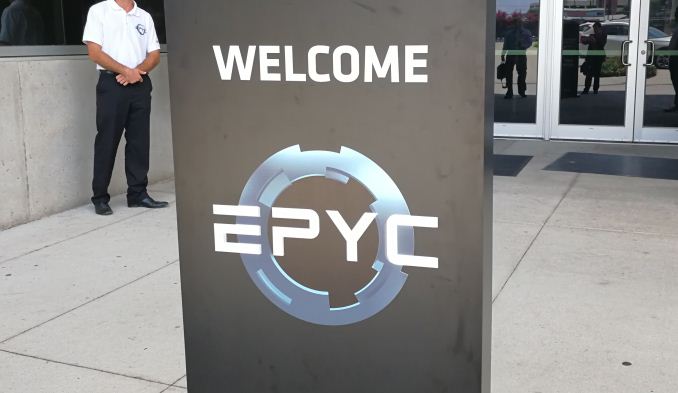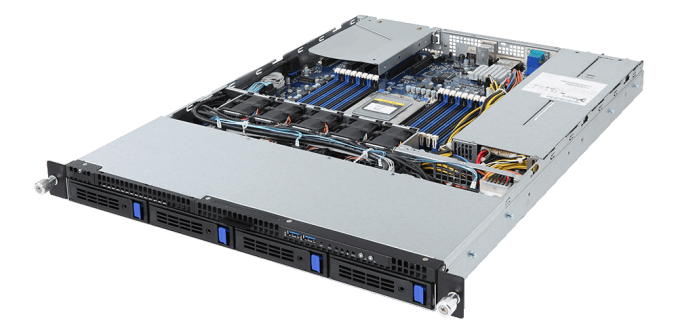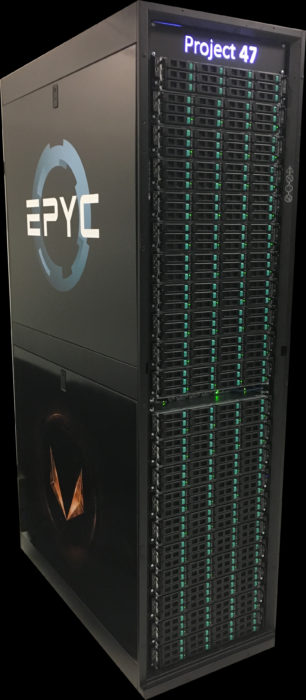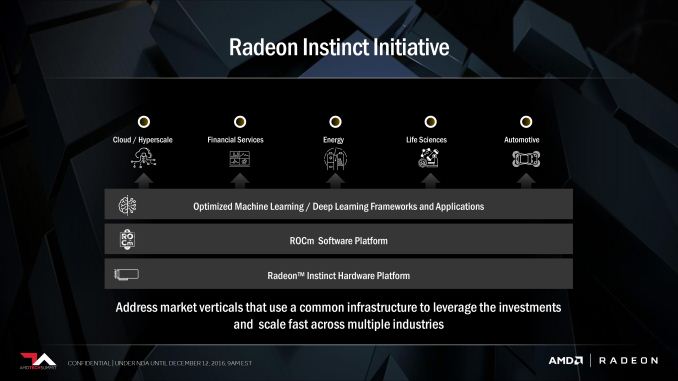AMD Announces Wider EPYC Availability and ROCm 1.7 with TensorFlow Support
by Ian Cutress on November 13, 2017 8:01 AM EST- Posted in
- CPUs
- AMD
- Gigabyte
- Asus
- Trade Shows
- Supermicro
- Tyan
- BOXX
- SC17
- HPE
- ROCm
- EPYC
- Supercomputing 17
- TensorFlow

Earlier this year AMD announced its return to the high-end server market with a series of new EPYC processors. Inside is AMD’s new Zen core, up to 32 of them, with the focus on the major cloud providers. We were the first media outlet to publish our review of EPYC, which showed AMD to be highly competitive in an Intel dominated x86 landscape. One of the concerns over the launch period was for the wider availability of EPYC: it was clear that AMD was announcing the product very early in its distribution cycle.
At SuperComputing 17 this week, the enterprise computing conference, AMD is announcing that it has ramped production of the processors and it has several OEMs ready, distributors ready, and system integrators expanding their portfolios.
OEMs with EPYC enabled systems at Supercomputing this week include ASUS, BOXX, GIGABYTE, HPE (Hewlett Packard Enterprise), Penguin Computing, Supermicro and Tyan. Each company is targeting certain niches: ASUS for HPC and Virtualization with its RS720A-E9 and RS700A-E9 1U/2U servers, BOXX combining EPYC with Radeon Instinct for multi-GPU compute solutions and deep learning, GIGABYTE with rackmount servers, HPE for complex workloads and Supermicro moving from tower form factors to 1U, 2U and 4U for HPC and storage.
“The industry’s leading system providers are here at SC17 with a full breadth of AMD-based solutions that deliver outstanding compute capability across HPC workloads,” said Forrest Norrod, SVP and GM of Enterprise, Embedded and Semi-Custom, AMD.
We had a meeting with AMD for this launch. Normally OEM systems coming to the market might not light the news on fire, but we did have an interesting line worth mentioning. AMD stated that there has been a steep production ramp for EPYC processors, after the initial phase with the cloud providers ensuring that the systems are ready to go, and so are ready to meet OEM requirements. We were told that all the SKUs announced at launch are in production as well, all the way down to the 8-core and the 1P parts, so OEMs that are interested in the full stack can now flex their product range muscles.
AMD also wheeled out the Inventec P47 system that it announced at launch, with a single EPYC processor and four Radeon Instinct MI25 GPUs. In partnership with AMAX, 47 of these systems were put together into a single rack, capable of one PetaFLOP of single precision in a turnkey solution. From today, AMAX is now taking pre-orders for this rack, for delivery in Q1.
ROCm 1.7 Gets Multi-GPU Support, Support for TensorFlow and Caffe
AMD also announced that its open-compute platform for graphics, ROCm, is being updated to 1.7. With this revision, ROCm adds support for multiple GPUs for the latest hardware, as well as support for TensorFlow and Caffe machine learning frameworks in the MIOpen libraries. This should be bigger news, given the prevalence of TensorFlow when it comes to machine learning. AMD also stated that ROCm 1.7 delivers additional math libraries and software development support, to provide a ‘foundation for a heterogeneous computing strategy’.




















20 Comments
View All Comments
IGTrading - Monday, November 13, 2017 - link
I wonder where are DELL's AMD EPYC servers.DELL had only wonderful things to say about AMD's EPYC and DELL not considers AMD EPYC to be the top performing solution they have, with Xeon being "the regular offering" .
DELL : "AMD's new processors are epic!" https://www.youtube.com/watch?v=KW6y5NfHffw
"Storage is key! AMD's competitors don't have the necessary IO."
DELL : "AMD's EPYC bring the best x3" https://www.youtube.com/watch?v=D1-1WgL2Jas
Although they apparently keep those "best x3" a secret / surprise.
It is bizarre to not see DELL and EMC in AMD's announcement.
Sinister1 - Monday, November 13, 2017 - link
Stay tuned... Should hear something any day now.vanilla_gorilla - Monday, November 13, 2017 - link
Not much of an announcement at all, don't know why you would expect to see partners involved.ddriver - Monday, November 13, 2017 - link
When are they gonna announce availability of higher clock speed? Even the 8 core epyc has abysmal clocks. It is not like they ran out of thermal or power budget, and obviously the core can do a lot better. WTF amd?bill.rookard - Monday, November 13, 2017 - link
Remember, usually the lower core count EPYC (and Ryzen/Threadripper CPUs) have errors in some of their cores so they may not be exactly 'the best' silicon overall. This might also limit their clockspeed. It could also be that they're aimed at a particular TDP for smaller enclosures, and as such - they could be clocked down somewhat for design reasons.Also - the Zen (v1) cores aren't really capable of going over 4.0/4.1 ghz anyhow without significant cooling and power delivery, which is something not really available in a server environment.
IGTrading - Monday, November 13, 2017 - link
" errors in some of their cores " ?!?!?!What nonsense is this ?!
Some chips reach lower clock with perfect stability so they're badged with lower model numbers.
If some cores don't work fast enough (or some transistors don't work reliably), those cores are disabled and the CPU is sold as a model with less than 32 cores.
There are no chips "with errors" being sold.
Dragonstongue - Monday, November 13, 2017 - link
limit of the design seems like, just because Intel can do 4.5Ghz+ does not automatically mean AMD should be able to do it or outright failure on their part, completely different design from completely different company results in a completely different, well, result. even with their "limited clock speed" there is a lot of performance in them, at least they are built VERY well at a reasonable to excellent price not using a crap ton of power.When target clock speed first you get something like Bulldozer or Pentium 4, the advantage of raw clock speed is useful in SOME things, but, not EVERYTHING, they addressed many of the shortcomings they had coming from previous designs, better IMC, better HT speeds, lower latencies, reduced temperature, reduced average power (when considering they are powering 4 to 8x more cores and threads not easy to achieve)
All in all, keep in mind AMD is a much much smaller company with limited funding trying to do what they can, IMO are doing an amazing job "keeping up" with 2 of the major companies in the tech world where other companies out there simply have no chance to compete with (cpu-gpu are incredibly hard to design and massively expensive)
be happy they made EPYC in first place you knucklehead ^.^
ddriver - Monday, November 13, 2017 - link
You didn't get the obvious - 16 core TR has 3.4 ghz base clock and boosts to 4 ghz, 8 core epyc has 2.1 ghz base clocks and boosts to 2.9 ghz.Clearly that doesn't go anywhere near the uarch maximum.
I am not asking where is the 5 ghz 8 core epyc, I am asking where is the 3.4 ghz epyc, 2.1 is quite a bit lower. And for the 8 core sku, it definitely is not out of thermal or power budget.
ddriver - Monday, November 13, 2017 - link
In fact, even the 24 core epyc has higher clocks - 2.3 base and 3.2 boost. The 8 core seems pathetically underclocked. Obviously it should be able to do a lot higher than 2.1.PixyMisa - Monday, November 13, 2017 - link
They could do a 3.6 - 4.0GHz EPYC, but it would be a 400W monster. They're going for efficiency rather than clock speeds.